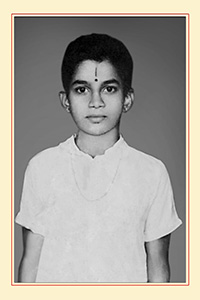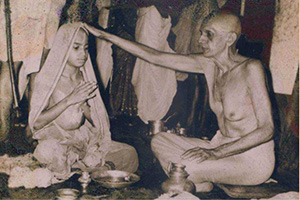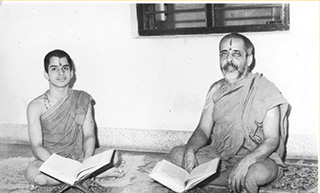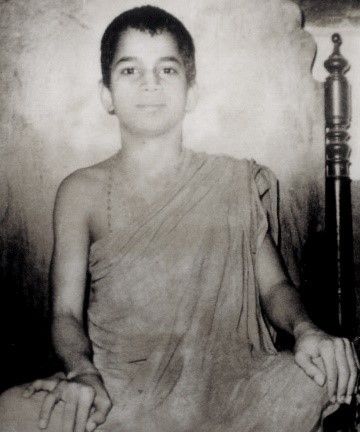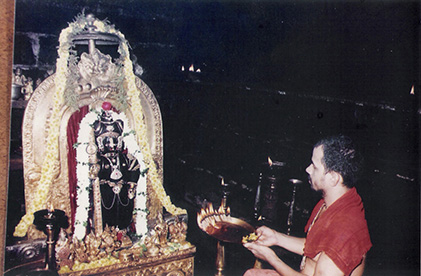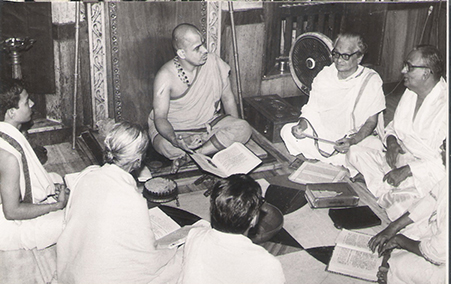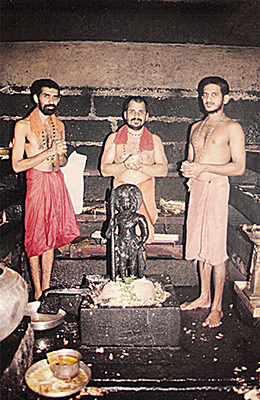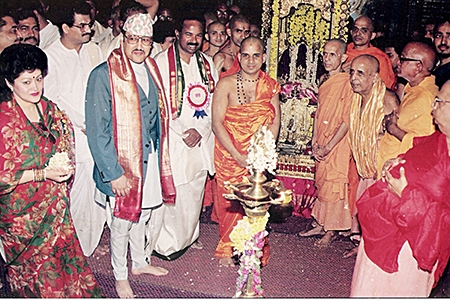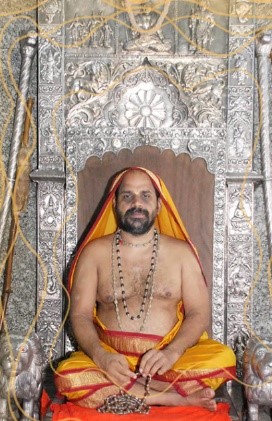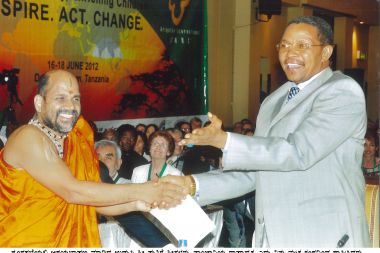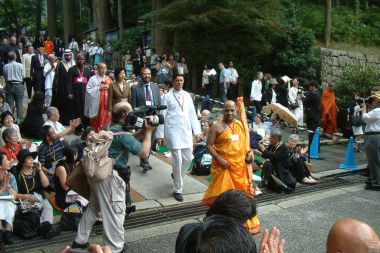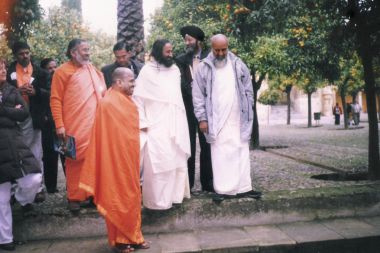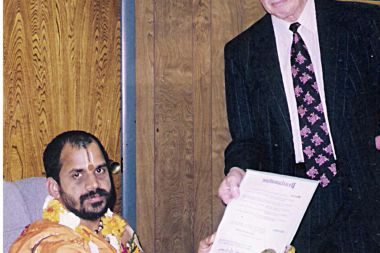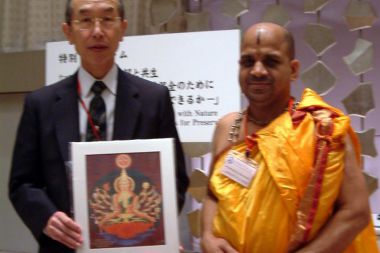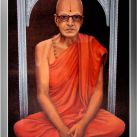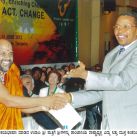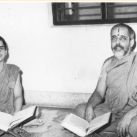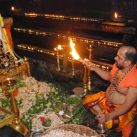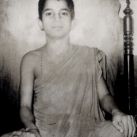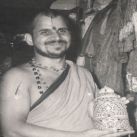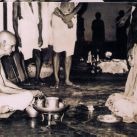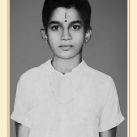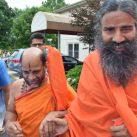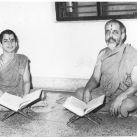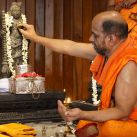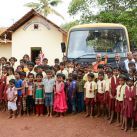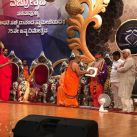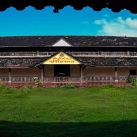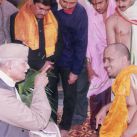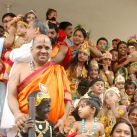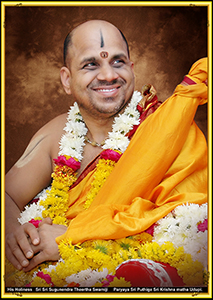
His Holiness Shri Shri Shri Sugunendra Theertha Swamiji, of Jagadguru Sri Madhwaachaarya Moola Mahaa Samsthaanam, Shri Puthige Matha, Udupi, India, was predestined at the age of 12 as the 30th Pontiff of the 750 years old illustrious and everlasting Indian Vedic traditional lineage of Jagadguru Sri Madhwaachaarya, the founder of the famous vedic philosophy of Dwaitha.
His Holiness Shri Sugunendra tirtha Swamiji prior to ascetic life(poorvarshrama) was known as Hayavadana Acharya. He was born on 15th September 1961(Bhadrapada masa shukla paksha shasti, Vishaka nakashatra) to a very pious and devout couple Smt Kamalamma and Sri Govinda Acharya in a small village called Maniyur, Udupi District. His parents were ardent devotee of Lord Krishna, hailing from a traditional orthodox Taulava brahmin family they always instilled in him great characters like honesty, compassion, love and mutual respect, other moral and human values to Hayavadana.
He was admitted to Kemundelu Government school by his parents for primary basic education, right from his early childhood days Hayavadana always had very sharp intellect, keen to learn new things, add values to all the work he does not to accept anything blindfolded but at the sametime respect elders. He had shown deep interest towards devotion (bhakti), spirituality(adhyatama) and was averse to mundane things. His sacred thread ceremony was performed at the age of five by his parents following as per the scriptures.
The then pontiff of Shri Puttige mutt Sujnanendra tirtha Swamiji was in quest of a worthy disciple(sishya) and a successor for the divine throne, he had gone through nearly five hundred horoscope (jathakas) hailing from different mutts and places, finally his search came to end when he came across Hayavadana’s horoscope which was meticulously evaluated by several renowned scholars(pundits) and they eventually gave nod for his ascension, thus Hayavadana Acharya was initiated to the highest order of monastery life by Sujnanendra tirtha Swamiji on 8th April, 1974 ( Chaitra masa Krishna paksha Tritiya, Swati nakshatra) in ShriPuttige mutt, Udupi, since then he’s been revered as Sugunendra tirtha Swamiji , a landmark and dawn of new era in Shri Putthige mutt lineage.
Shri Sujnanedra tirtha swamiji after giving sanyasa deeksha to Shri Sugunendra tirtha Swamiji was there for around just three months in this world, then he left his mortal body and attained Haripada. During those times Shri Vibhudesha tirtharu had invited Shri Vidyamanya tirtharu to Adamar mutt and train his disciple Shri Vishwapriya tirtharu, at that time Shri Vidymanya tirtharu decided to accommodate and train other yatis along with Shri Vishwapriya tirtharu, i.e. Shri Vidyadheesa tirtharu of Adamar mutt, Shri Vidyesha tirtharu of Bhandarkeri mutt, Shri Sugunedra tirtharu of ShriPuttige mutt.
His Holiness Shri Vidyamanya Theertha Swamiji was a renowned scholar and a saint, he was the spiritual and academic teacher of Sri Sugunendra Theertha Swamiji. Sugunendra Swamiji for twelfth years had studied under the tutelage of Shri Vidyamanya tirtha Swamiji all the four branches of Veda, Upanishads, Pancharatra agama, Nyaya, Vyakarana, Tarka, Shriman Nyayasudha and Vysasatraya, and all other Sarvamoola granthas of Shrimadhacharya. Along with other Indian philosophies he had particularly mastered and built a fort around Dwaitha tattva vadha.
His Holiness Shri Sugunendra tirtha Swamiji at the age of fifteen was the youngest of all the yatis to ascend the Sarvanga peeta and complete the paryaya for the first time in the history of Shri Krishna mutt spanning over 750 years, even the people closest to Shri samsthana and his ardent well-wishers were amused how can a young swamiji bear the onus and complete such humongous task with no prior experience.
His holiness Shri Sugunendra tirtha Swamiji had executed his responsibilities unblemished with utmost devotion to Lord Krishna & Mukhyaprana, this earned him rich praises from senior pontiffs of other mutts.
His Holiness Shri Sugunendra tirtha Swamiji ascended the divine throne for the second time when he was in his early thirties, it was during this paryaya he took bigger sankalpas like.
This structure is a landmark for Udupi and gives a distinct identity for itself and is associated with high emotional values to the people visiting Udupi Krishna mutt.
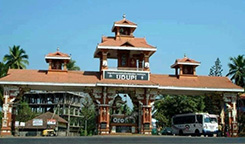
His Holiness Shri Sugunendra tirtha Swamiji understood the challenges faced by numerous pilgrims visiting Udupi with accommodation, so he constructed a guest house ‘Indraprastha’ which is big enough and can accommodate hundreds of people.
The foundation of this structure was laid by the then President of India Dr. Shankar Dayal Sharma and later the building was inaugurated by the then king of Nepal – Birenda Bir Bikram Shah in 1993. This magnificent multi-storeyed building hosts the Dhyana Mandir for the pilgrims to meditate, Madhva Mandir, Akshara Mandir and the Vishwaroopa Darshana.
Inside the Gita Mandir all the 700 shlokas of Bhagavad Gita in Sanskrit have been transcribed on the black granite stone, also in another hall there are several thousand copies of Bhagavad-Gita published in various languages across the world. This was one of the long pending dream projects of HH Sugunendra tirtha Swamiji close to his heart which eventually got materialized later in his second paryaya and cherished by him.
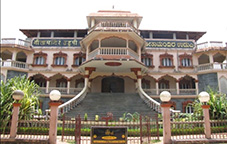
This is yet another magnificent sankalpa taken by HH Sugunendra tirtha Swamiji during his second paryaya in alleviating hunger as irrespective of age, gender, place and social status, etc every human being can feel hunger, and this is the only quest which can be quenched wherein a devotee after having sumptuous food feels and says “enough.
I’m done, I can’t have more, I’m satisfied.” It doesn’t matter whether they were devotees of Lord Krishna, school/college students out on an excursion, people coming from nearby far off places, everyone are welcomed with open arms with open heart and prasadam is served in the Krishna mutt. This was a commendable accomplishment which needs to be acknowledged and reciprocated with gratitude to HH Sugunendra tirtha Swamiji.
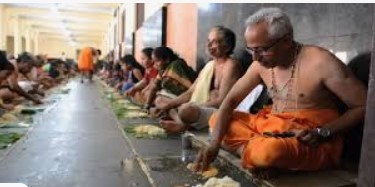
The third paryaya had evoked a lot of interests not only within India, across the globe as by that time HH Sugunendra tirtha Swamiji had become a world renowned saint as he had travelled to numerous countries and met several world renowned political and religious leaders which made him apple of the eye. This event was witnessed by large number of devotees, scholars, political and religious leaders, statesmen, celebrities, artists, worldwide media making it truly an international event.
It was during this third paryaya he had contributed Navaratna Kachita ratha(chariot). The ratha was named Navratna ratha as it measures nine feet height, weighs about two tonnes, it consists 500kg of copper, 18kg of silver, 12 kg of gold and studded with 1.5 lakh gemstones.
Accomplishments
His Holiness Sri Sri Sugunendra Theertha Swamiji’s crusade to the west happened almost 11 years ago. It was because of the strong desire and the quest for Madhva philosophy of the members of Cyber Madhva Sangha, which eventually became Vishwa Madhva Sangha, which motivated His Holiness to take this revolutionary step. He became a source of knowledge for some dedicated Madhva devotees. Swamiji’s accessibility to all devotees was easily realized because of the advent of internet and mobile phone. Very quickly Swamiji’s name and fame spread even outside the Madhva circle.
Sometime during the early 1999, an International Multifaith Organization called ‘Religions for Peace’ (formally known as World Conference on Religions for Peace’ -WCRP) invited His Holiness to join the interreligious community and work for World Peace through interfaith peace dialogue. Swamiji was formally introduced to this global platform in November 1999 in Jordan, Amman, where He addressed the 7th World Assembly of Religions for Peace as a senior Hindu Religious Leader. During the same occasion, He was elected to the governing body of Religions for Peace as one of the International Presidents, representing Hindu Community. Thus Swamiji became the ‘Hindu face’ and ‘Hindu Voice’ of Religions for Peace.
Religions for Peace facilitate connection among its affiliates across National, Regional and International levels to foster creative multireligious solutions to challenging problems. From sharing lessons learned between countries to building action alliances among its affiliates, the Religions for Peace demonstrate the unique power of a coordinated global approach. Sharing information and experiences, Conflict transformation, Peace Building through interfaith dialogue and building alliances are some of the key features of Religions for Peace.

